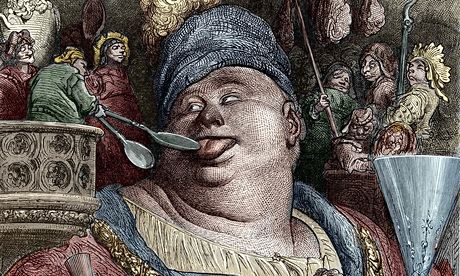From Mrs Malaprop to Lothario to the Grinch, some characters are so memorable that they leap from fiction into the dictionary. Take an alphabetical tour of the origins of some of our most familiar – and not-so-familiar – literary eponyms
Hugely memorable … detail from Gustave Doré's illustration of Rabelais' Gargantua. Illustration: Stefano Bianchetti/Corbis
BLUEBEARD
The monstrous Duke Bluebeard first appeared in Charles Perrault's collection of fairytales, Histoires ou contes du tempes passé, in 1697. A serial murderer who kills a string of wives and keeps their bodies locked in a secret room in his castle, Bluebeard soon came to refer to any violent womaniser or wife-killer in 18th-century English, while a Bluebeard's closet or Bluebeard's room is anywhere a person keeps something they wish to remain a secret.BRAINIAC
Before it became a nickname for an exceptionally clever or geekish person, brainiac was the name of a super-intelligent adversary of Superman who first appeared in an edition of Action Comics in 1958.BUNBURYING
In Oscar Wilde's Importance of Being Earnest (1899), Algernon admits to having a fictitious friend called Bunbury – "an invaluable permanent invalid" – who supposedly lives away in the country, and whom he "visits" whenever he wishes to excuse himself from a social obligation. Bunburying, a term Wilde himself coined in the play, has since been widely adopted beyond the theatre for similar prevarication.More

No comments:
Post a Comment